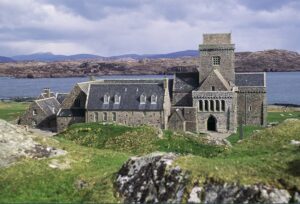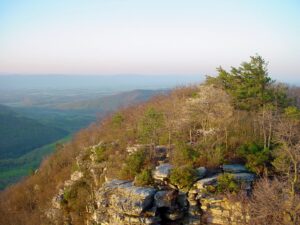Do you ever notice how often people post photos of sunrises or sunsets on social media? “Inspiring,” they say. Or the religious types write, “Good morning from God.”
 In my personal photo collection, I have scads of dawns and dusks. Sunrise in the swamp. Sunset from a mountaintop.
In my personal photo collection, I have scads of dawns and dusks. Sunrise in the swamp. Sunset from a mountaintop.
Then there was the sunrise etched in my memory when I found myself without a camera. I spent the night alone on a platform in the Blue Ridge Mountains in North Carolina. It was chilly, so I braced myself against the cold covered up in my sleeping bag. At first light, I sensed something special was about to happen.
Indeed, it did. I sat up with a start and looked east. Moments before the sun inched above the distant ridge of mountains, a deep purple line separated the night sky from the ridgeline. It couldn’t have lasted more than a few minutes. I had never seen such a beautiful mountain dawn before. I haven’t since.
The “Thin Place” between physical and spiritual worlds

Iona Abbey, Scotland
That mountain was a “thin place.” The term is used to describe places of sacred power, where the separation between physical and spiritual worlds seems “thin.” There are sermons about thin places, like in the story of the Transfiguration.
In that story, Jesus shines with bright light on a mountaintop before his disciples. The mountain becomes a symbol of the meeting point between humans and God – between the physical and spiritual – with Jesus representing the connection between both worlds. Long before cameras or social media, Peter wanted to capture the moment and build three shrines to contain this heavenly appearance. Jesus would have none of it.
Thin places are most often associated with spiritual retreats, like the Scottish island of Iona, which I visited while on a Celtic Christianity pilgrimage. Being in places like this invites thoughts of things spiritual.

Hank’s “thin place” – campsite on The Big Schloss
There’s also a thin place, for me, on The Big Schloss, a rock outcrop on the Virginia-West Virginia border. I have probably spent thirty nights sleeping near the peak of this mountain, watching the sun rise and set. My children slept up there with me. We saw Halley’s comet there.
Even atheist author Sam Harris speaks of his own thin place experience. In his book, he describes how he was touched by a walk in Jesus’ footsteps. This happened on “an afternoon on the northwestern shore of the Sea of Galilee, atop the mount where Jesus is believed to have preached his most famous sermon,” Harris writes. “As I gazed at the surrounding hills, a feeling of peace came over me. It soon grew to a blissful stillness that silenced my thoughts. In an instant, the sense of being a separate self — an ‘I’ or a ‘me’ — vanished.” (Waking Up: A Guide to Spirituality Without Religion, p. 81)
“Thin Moments”

Photo by RODRIGO GONZALEZ on Unsplash
There are also “thin moments,” or moments in time that are transformed into a spiritual experience. In an earlier blog, I wrote about my sense of connection with others at the post office the first time I wore a mask inside. I quoted the monk (and sometimes hermit), Thomas Merton, and his sense of connection to all the busy shoppers at an intersection in Louisville.

Photo by Filip Mroz on Unsplash
More thin moments: Gazing into the face of an infant who is smiling for the first time. Walking outside at night and hearing an owl or a whip-poor-will. Listening to music that moves you. Then of course, there is always watching those sunsets and sunrises.
Thin moments could happen more often if we just paused long enough or weren’t so distracted or busy taking pictures to post. We don’t have to be at the top of a mountain or by the seashore. The promise from scripture is, “I am with you always.”
__________________________________________
Chaplain Hank Dunn is the author of Hard Choices for Loving People: CPR, Feeding Tubes, Palliative Care, Comfort Measures and the Patient with a Serious Illness and Light in the Shadows. Together they have sold over 4 million copies. You can purchase his books at hankdunn.com or on Amazon.





